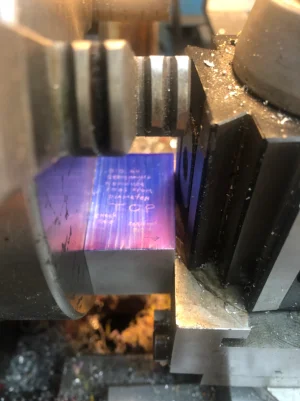Tomc938
Ultra Member
Yesterday I was working in the shop when I came across what I thought was a small piece of scrap aluminum. I looked at it close, and saw engraved on one side: "0.010 on the cross feed removes 0.001 on the diameter" and indications that one side goes up against the chuck and the other side on the cross slide. Sure enough, when I put the one side on the face of the chuck and the other side on the "face" of the cross slide 0.010 feed on the cross slide removed exactly 0.001 from the diameter!
I got my lathe and milling machine from a retired tool maker. He also threw in a couple of Kennedy boxes full of tools and some small scraps of metal. This jig was in a toolbox and I guess I thought it was just a block and put it into my scrap pile.
I'm glad I found it! It's going to prove very handy when I need to take precise amounts off stock.
If I'm reading Machinery's Handbook correctly, the angle is 5° 43'.
The block makes this setup quick and repeatable. You might want to look at making a block like this for yourself.
(On a side note, I was wondering when I brought the lathe home why he had the cross slide lined up with the axis of the lathe rather than the normal 30 degrees I usually work with. I'm guessing his normal position for the cross slide was off by 5° 43' and I just didn't notice the slight difference)


I got my lathe and milling machine from a retired tool maker. He also threw in a couple of Kennedy boxes full of tools and some small scraps of metal. This jig was in a toolbox and I guess I thought it was just a block and put it into my scrap pile.
I'm glad I found it! It's going to prove very handy when I need to take precise amounts off stock.
If I'm reading Machinery's Handbook correctly, the angle is 5° 43'.
The block makes this setup quick and repeatable. You might want to look at making a block like this for yourself.
(On a side note, I was wondering when I brought the lathe home why he had the cross slide lined up with the axis of the lathe rather than the normal 30 degrees I usually work with. I'm guessing his normal position for the cross slide was off by 5° 43' and I just didn't notice the slight difference)



